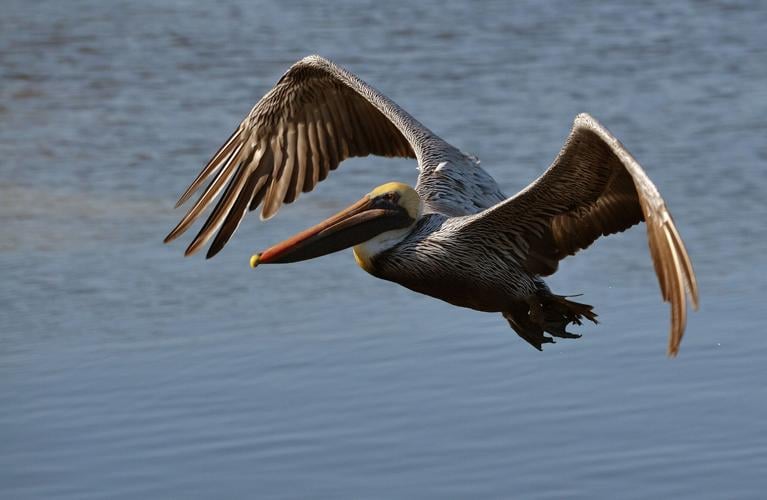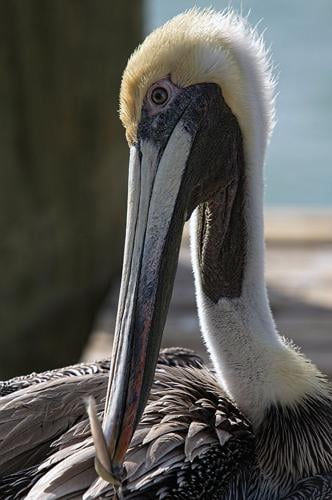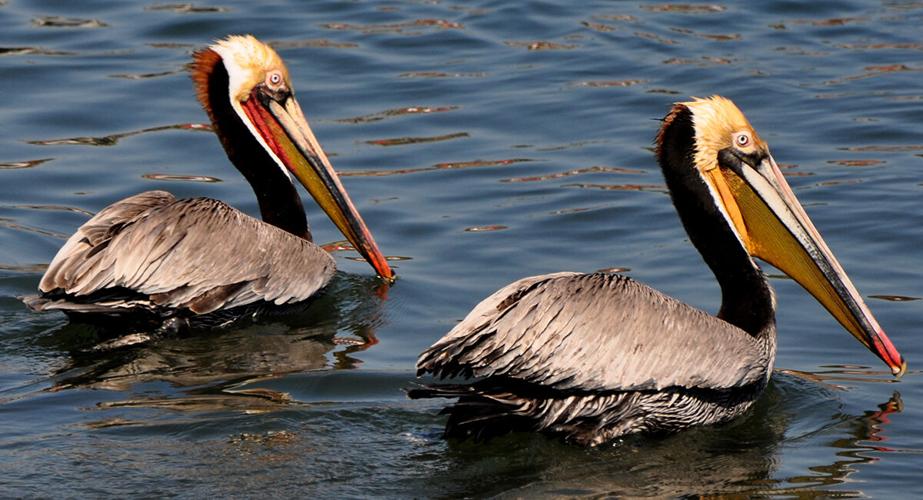
Ungainly physique notwithstanding, the bird is a graceful flier and expert swimmer. (Cindy Elder/CC BY 2.0)
I was in North Carolina the first time I saw a brown pelican (Pelecanus occidentalis) and was immediately taken by this odd bird. Brown pelicans may look gawky on land, but when they take to the skies, they fly with elegance.
There are several subspecies of brown pelican, and the eastern or Atlantic variety (P. occidentalis occidentalis) is the smallest and considerably smaller than its continental cousin, the American white pelican. The eastern brown is nevertheless a sizable bird, weighing 8–10 pounds and measuring up to 54 inches long, with a wingspan of 6–7 feet. It has a chestnut and white neck, a white head, pale yellow crown, brown back, grayish bill and pouch, and black legs and feet.
This bird can remain in flight for hours at a time using slow, powerful wing beats. While flying, it draws its head in between its shoulders, stretches out its broad webbed feet and flies in perfect silence. It’s also a strong swimmer. Young pelicans — before they can even fly — have been clocked swimming at 3 miles per hour.
Pelicans are primarily fish eaters and require up to 4 pounds of fish a day. They have extremely keen eyesight and can see a single fish from 70 feet above the water. Once they spot a meal, they abruptly fold their wings and drop from the air, diving straight as an arrow into the water, sometimes submerging completely before surfacing with a mouthful of fish.

This brown pelican was photographed in Key West, FL. Although more common to the southeast, they have been nesting in the lower part of the Chesapeake Bay since 1987. (Will Pollard/CC BY-ND 2.0)
Suspended from the lower half of a pelican’s long, straight bill is a pouch that is used as a dipnet. The pouch holds the pelican’s catch until the water, as much as 3 gallons, is squeezed out. The pouch also serves as a cooling mechanism, as well as a feeding trough for young pelicans.
These are social and gregarious birds. Males and females, juveniles and adults, congregate in large flocks for much of the year, nesting in colonies mostly on small coastal islands — which offer protection from predators and flooding.
Newly hatched pelicans, like many young birds, are blind, featherless and completely dependent upon their parents. They soon develop a soft, silky down, followed by feathers. The average age at first flight is 75 days.
Young are fed with great care, with partially digested fish that the adult disgorges on demand. For the youngest chicks, the parent drops mashed fish into the youngster’s extended throats. Later they feed them whole fish, and finally the parent merely places the fish on the edge of the nest.
Although more common to the southeast, brown pelicans have been nesting in the lower part of the Chesapeake Bay since 1987. More recently, they have moved northward into the mid Bay, on islands near the Virginia-Maryland border.
Brown pelicans have few natural enemies. Their biggest threat has been people. In the late 1800s and early 1900s, pelicans were hunted for their feathers. After World War I, pelicans were hunted because it was thought that they were depleting commercial fisheries. And, as with other large fish-eating birds, use of the pesticide DDT in the 1940s and ’50s decimated the pelican population by compromising the strength of their eggshells.

Brown pelicans have few natural enemies. (Dave Hensley/CC BY-NC-ND 2.0)
Several efforts curbed the decline of brown pelicans. Early on, passage of the Migratory Bird Treaty Act in 1918 gave protection to pelicans and other birds from feather collectors. Studies proving the pelicans were not harming commercial fisheries also helped to stop illegal hunting.
In 1970, the brown pelican was listed as an endangered species, affording it more protection, and in 1972 the use of DDT was banned in the United States.
Together, these actions have helped to bring brown pelicans back from the brink. By 1985, their numbers on the Atlantic and Gulf coasts had rebounded to the point that they could be removed from the endangered species list in that part of their range. By 2009, they had recovered throughout the rest of their range.
Although the species is doing well on the Atlantic Coast, threats remain. The disturbance of nesting colonies, birds caught on fishhooks or entangled in monofilament line, and oil or chemical spills still pose a threat to this wonderful bird.
Yet these potential threats are situations we can prevent — by protecting known colonies during nesting, disposing fishing gear properly and enforcing laws that reduce the possibility of spills in our waters.



(0) comments
Welcome to the discussion.
Log In
We aim to provide a forum for fair and open dialogue.
Please use language that is accurate and respectful.
Comments may not include:
* Insults, verbal attacks or degrading statements
* Explicit or vulgar language
* Information that violates a person's right to privacy
* Advertising or solicitations
* Misrepresentation of your identity or affiliation
* Incorrect, fraudulent or misleading content
* Spam or comments that do not pertain to the posted article
We reserve the right to edit or decline comments that do follow these guidelines.